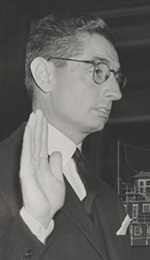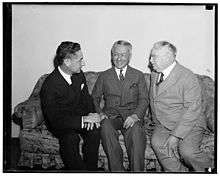Joaquín Miguel Elizalde
Joaquín Miguel Elizalde y Díaz (August 2, 1896 – February 9, 1965) was a Filipino diplomat and businessman.
Joaquín M. Elizalde Díaz | |
|---|---|
 | |
| Secretary of Foreign Affairs | |
| In office April 18, 1952 – December 30, 1953 | |
| President | Elpidio Quirino |
| Preceded by | Carlos P. Romulo |
| Succeeded by | Carlos P. Garcia |
| Resident Commissioner to the U.S. House of Representatives from the Philippine Islands | |
| In office September 29, 1938 – August 9, 1944 | |
| Preceded by | Quintin Paredes |
| Succeeded by | Carlos P. Romulo |
| Personal details | |
| Born | Joaquín Miguel Elizalde y Díaz August 2, 1896 Manila, Captaincy General of the Philippines |
| Died | February 9, 1965 (aged 68) Washington, D.C., United States |
| Military service | |
| Allegiance | |
| Branch/service | Philippine Commonwealth Army |
| Rank | Major |
| Battles/wars | World War II |
Personal life
Elizalde was born on August 2, 1896 in Manila, the eldest child of José Joaquín Elizalde (who was the Philippine-born son of Joaquín Marcelino Elizalde y Yrisarry, an immigrant from Elizondo in Navarre, Spain) and Carmen Díaz y Moreau (who was from Spain).[1] His siblings were Juan Miguel, Ángel, Manuel ("Manolo"), Federico ("Fred") and Carmenchu.
He was educated at St. Joseph's College, London, and Dr. Schmidt's Institute in St. Gallen, Switzerland.
Elizalde was married to Elena von Kauffmann in 1924 and had two daughters, Cecilia and Elenita. The couple divorced in 1957.
He later married Susan Magalona (born Susana Clarita Magalona y Gayoso, 1921-2014), daughter of Philippine senator Enrique Magalona and sister of Filipino actor Pancho Magalona. The couple had two children, Maria Theresa ("Tracey") and Juan Miguel ("J.M.", died 2007).[2]
Business career
In 1936, Elizalde and his brothers established Elizalde & Company, Inc. after acquiring the major businesses of Ynchausti y Compañía, among them Ynchausti Shipping, Tanduay, YCO Paints and Floor Wax, Rizal Cement, and the Central Azucarera de La Carlota and Central Azucarera de Pilar (now Capiz Sugar Central) sugar refineries.
Elizalde was the company's first president. After World War II, he decided to focus on his diplomatic career and was succeeded as president of the company by his brother Manolo.[3]
Diplomatic career
Elizalde became an economic adviser to President Manuel L. Quezon in 1937 and 1938. He became a member of the National Economic Council 1937–1941 and 1952 and 1953, and of the Joint Preparatory Committee on Philippine Affairs in 1936 and 1937. He was also a member of the Council of State 1936 to 1941 and 1952 to 1953 and served as Major of the Cavalry Reserve, Philippine Army.

As Resident Commissioner to the U.S. House of Representatives
Elizalde was appointed Resident Commissioner to the U.S. House of Representatives on September 29, 1938, to fill the vacancy caused by the resignation of Quintin Paredes and served until his resignation on August 9, 1944. He became a member of the war cabinet of President Quezon in 1941.
As International Monetary Fund governor
In 1946, he became a member of the board of governors of the International Monetary Fund and of the International Bank for Reconstruction and Development until 1950 and was the Philippine ambassador to the United States from July 6, 1946 until January 1952.
He was the first of only two former US congressmen to later serve as an ambassador from another country.[4]
Secretary of Foreign Affairs under President Quirino
He also served as Secretary of Foreign Affairs of the Republic of the Philippines from 1952 to 1953, under the administration of President Elpidio Quirino and an economic adviser to the Philippine Mission at the United Nations, with the rank of Ambassador from 1956 to 1965. He represented the Philippines at the coronation of Elizabeth II on June 2, 1953.[5]
Polo
He was an avid polo player together with his brothers, Juan Miguel, Ángel and Manolo. In January 1937, the Elizalde brothers inaugurated the Los Tamaraos Polo Club in Tambo, Parañaque after resigning their memberships in the Manila Polo Club in protest to the rejection of the membership application of Manuel Nieto, aide-de-camp of Philippine President Manuel L. Quezon. The Elizalde brothers proposed and seconded Nieto's membership application.[6][7]
Retirement and death
Elizalde resided in Moreland Farm, Adamstown, Frederick County, Maryland which he acquired in 1949. He died on February 9, 1965 and was buried at St. Joseph Church cemetery, Carrollton Manor, Frederick County, Maryland.
See also
- United States Congressional Delegations from Philippines
- Department of Foreign Affairs (Philippines)
- List of Hispanic and Latino Americans in the United States Congress
References
- Borja, Marciano R. De (16 April 2018). "Basques in the Philippines". University of Nevada Press. Retrieved 16 April 2018 – via Google Books.
- "Elizalde, Joaquin Miguel". History, Art & Archives, U.S. House of Representatives. Retrieved 26 May 2018.
- de Borja, Marciano R (2005). Basques in the Philippines. Nevada: University of Nevada Press. pp. 128–131. ISBN 0-87417-590-9.
- "Embassy of the Philippines - Embassy of the Philippines, Washington, D.C." www.philippineembassy-usa.org. Archived from the original on 30 October 2014. Retrieved 16 April 2018.
- "Official Month in Review: November 1952". Official Gazette of the Republic of the Philippines. Retrieved 17 May 2020.
- Harrison, F.B. "Diary of Francis Burton Harrison, March 24, 1935". The Philippine Diary Project. Retrieved 31 May 2018.
- "Polo history in the Philippines". The Manila Times. 5 July 2014. Retrieved 31 May 2018.
External links
- United States Congress. "Joaquín Miguel Elizalde (id: E000108)". Biographical Directory of the United States Congress.
| U.S. House of Representatives | ||
|---|---|---|
| Preceded by Quintin Paredes |
Resident Commissioner from the Philippines to the United States Congress 1938–1944 |
Succeeded by Carlos P. Romulo |
![]()